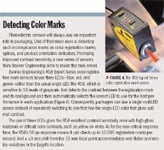For decades, photoelectric sensors have been ubiquitous on packaging lines—triggering processes, counting, checking for label presence, sorting objects of different sizes, and performing dozens of other tasks. Even so, their usefulness has been limited by their single beam and lack of brain power. That's where low-cost vision sensors can help. Vision sensors are especially well suited to applications that are too complicated for photoelectrics or that require complex fixturing.
Often the Obvious Answer
Because vision sensors capture and analyze a multipixel image, they are an obvious choice for inspections that require several photoelectric sensors but not complex enough for human inspection: for example, ensuring that package labels are present and properly aligned, that bottles are capped, or that cartons contain the proper number of units (Figure 1).
 Figure 1. Package inspection by a PresencePLUS P4 GEO 1.3 vision sensor |
In these relatively simple applications, vision sensors provide the usual advantages of automation—speed and accuracy—at a lower cost per inspection than human inspections. But creative packaging engineers are also discovering ways to use vision sensors for more complex applications:
- 1. A major food packaging company uses one vision sensor to detect the label on top of a package and another to read the bar code on the bottom. A PLC then determines whether or not the top and the bottom match.
- 2. Nice-Pak Products, which makes and packages most wet wipes on the market, uses a vision sensor to peek into the tiny opening of packets of individual towelettes to make sure the towelette is present at the moment a tube squirts in the liquid.
- 3. A bottling plant in Hong Kong inspects bottled soft drinks for foreign matter—such as a piece of plastic or paper—that might fall in during the bottling process. The sensor captures an image of the cap and bottle neck and then checks to see if the distance between the top of the bottle cap and the top of the liquid is within specifications. Foreign matter displaces the liquid, changing that distance.
 Figure 2. The PresencePLUS P4 OMNI and P4 OMNI 1.3 vision sensors |
The Critical Factors
Is a vision sensor the right solution for your application? Keep these three parameters in mind:
- 1. Lighting
- 2. Response time
- 3. Resolution
Lighting is the most important technical factor of any vision application because it determines the contrast between the feature of interest and the background. Changing the angle and position of lighting makes a drastic difference (Sidebar, "How You Light Is What You See,").
 How You Light Is What You See |
As an example of the key role lighting plays, consider the problem project engineers face when the design of a product label changes after they've planned the inspection orientation based on a mark on the label (Sidebar, "Detecting Color Marks,"). If the mark moves or is removed, they have to design a new inspection. A solution for eliminating the inspection system's reliance on package artwork is to specify a luminescent coating on the label surface and use a black light during the vision inspection to make the label glow against the background of the package.
 Detecting Color Marks |
Thorough testing reveals whether a single vision sensor can keep up with the assembly line. If not, inspection tasks can be divided among separate vision sensors, such as one for cap-and-fill inspection and another for label inspection.
When you use more than one vision sensor for an inspection—to improve response time or resolution—the packaging machine's control system must coordinate the data from the vision sensors. All vision sensors have traditional discrete I/O signals for passing and failing a part, but the latest generation of products supports such industry-standard Ethernet protocols as Ethernet IP or Modbus/TCP. These protocols allow a large amount of data to be transferred for each inspection cycle.
The Deciding Factor
Engineers who design packaging lines always weigh the costs and benefits. Because prices for self-contained vision sensors have dropped so low—some start under $1000—they're becoming an attractive choice for a variety of new applications. If you're used to working with photoelectrics, be advised that upgrading to vision sensors has a significant learning curve. The increased power, flexibility, and opportunity for creativity you gain, however, make up for that initial extra effort.
Steve Maves, BSEE, can be reached at Banner Engineering Corp., Minneapolis, MN; 763-544-3164, [email protected], www.banneregineering.com.